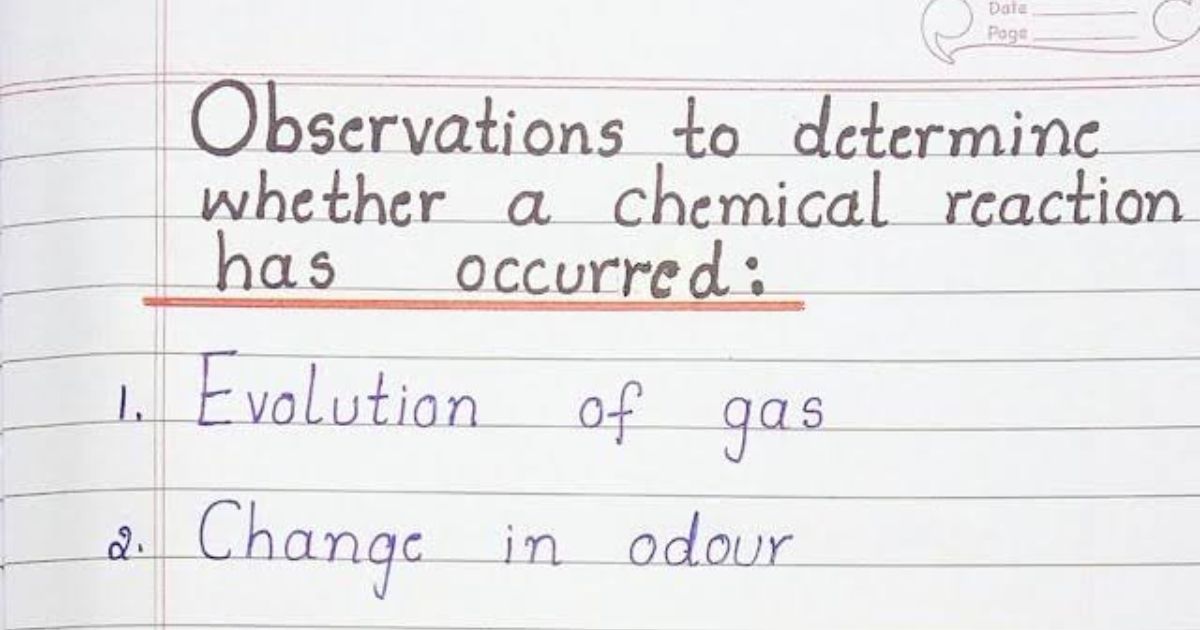Understanding whether a chemical reaction has occurred is fundamental to the study of chemistry. Chemical reactions involve the transformation of one or more substances into entirely new substances with different properties. But how does one know if such a transformation has actually occurred?
This article focuses on how Neha can determine that chemical reaction has happened. Whether Neha is a student, a curious observer in a laboratory, or simply someone experimenting in a home setup, recognizing the signs of a chemical reaction is essential. We’ll explore both theoretical and practical aspects, highlighting the observable changes, types of reactions, and experimental techniques Neha can use to identify a chemical reaction.
What Is a Chemical Reaction?
A chemical reaction is a process in which the chemical composition of a substance changes to form new substances with distinct physical and chemical properties. During a chemical reaction, atoms are rearranged, and chemical bonds are broken and formed.
For example, when hydrogen reacts with oxygen to form water, the reactants (hydrogen and oxygen) are chemically transformed into a new compound (water).
General form of a chemical reaction:
Reactants → Products
Why It’s Important to Identify a Chemical Reaction
Identifying a chemical reaction helps in:
- Understanding material transformations.
- Conducting laboratory experiments safely.
- Exploring real-world applications such as cooking, combustion, rusting, etc.
- Developing new materials in industries.
- Observing environmental changes like pollution or corrosion.
Now, let’s dive into the different ways how Neha can determine that chemical reaction has happened.
1. Observation of Physical Changes
The first method Neha can use is simple observation. Several visible or sensory changes indicate that a chemical reaction has taken place.
A. Change in Color
A sudden or gradual change in color during a reaction often signals a chemical change. For example:
- Copper sulfate solution is blue, but when iron is added, the solution turns green due to the formation of iron sulfate.
Experiment: Neha adds iron filings to blue copper sulfate solution and observes the color change.
B. Formation of a Precipitate
A precipitate is a solid that forms in a solution during a chemical reaction and settles out.
Example: Mixing silver nitrate and sodium chloride results in a white precipitate of silver chloride.
Experiment: Neha mixes AgNO₃ and NaCl solutions and observes white solid forming.
C. Evolution of Gas
The production of gas (bubbling, fizzing, or odor release) is a common sign of a reaction.
Example: Reaction of hydrochloric acid with zinc produces hydrogen gas.
Experiment: Neha adds zinc to dilute HCl and notices bubbles and hears a popping sound when a burning match is brought near the test tube mouth.
D. Change in Temperature
Many reactions release or absorb heat.
- Exothermic Reaction: Releases heat (e.g., combustion).
- Endothermic Reaction: Absorbs heat (e.g., dissolving ammonium nitrate in water).
Experiment: Neha mixes quicklime (CaO) with water and notices the container gets hot.
E. Emission of Light or Sound
Some chemical reactions emit light (e.g., fireworks) or sound.
Experiment: Burning magnesium ribbon produces bright white light.
2. Chemical Testing
Besides visual changes, Neha can use chemical indicators to determine if a reaction has happened.
A. Litmus Test
Using red and blue litmus papers, Neha can detect changes in pH, indicating acid-base reactions.
Example: Reaction of acid with a base forms salt and water, causing the litmus to return to neutral color.
B. pH Indicator
Universal indicators change color according to pH, helping detect acidic or basic products in reactions.
Experiment: Neha adds universal indicator to the product solution to verify chemical change in neutralization.
3. Energy Changes
Neha can measure temperature changes using a thermometer or observe light emission using visual clues.
- A significant rise in temperature = exothermic reaction
- A drop in temperature = endothermic reaction
Example: Neha dissolves barium hydroxide and ammonium chloride and observes a drop in temperature and formation of ammonia gas—clear indicators of a reaction.
4. Formation of New Substances
One of the most definitive signs that a chemical reaction has occurred is the creation of substances with properties different from the starting materials.
Example: Burning paper results in ash, smoke, and gases that have no resemblance to the original material.
Experiment: Neha burns a piece of magnesium and sees a white ash (magnesium oxide) form—a new substance.
5. Conducting Control Experiments
To confirm a chemical change, Neha can compare her experiment with a control setup that doesn’t include the reacting substance.
Example: She can test two beakers—one with vinegar and baking soda, and the other with only vinegar. The beaker with both will bubble (CO₂ gas evolution), confirming a chemical change.
6. Balancing and Analyzing Chemical Equations
Neha can write the chemical equations for the reaction and check if atoms are rearranged and if new substances are formed.
Example: Zn+HCl→ZnCl2+H2↑\text{Zn} + \text{HCl} \rightarrow \text{ZnCl}_2 + \text{H}_2↑
Here, zinc and hydrochloric acid react to form zinc chloride and hydrogen gas, a clear chemical transformation.
7. Identifying Irreversibility
Chemical changes are often irreversible under normal conditions. If Neha cannot easily get the original substances back, the reaction is chemical.
Example: Cooking an egg or baking a cake involves irreversible changes—clear signs of chemical reactions.
8. Using Instrumental Techniques (Advanced)
In a lab setting, Neha may use instruments to confirm chemical reactions:
- Spectrophotometer: To detect color/intensity change.
- Calorimeter: To measure energy change.
- Gas Chromatography or Mass Spectrometry: To identify new products.
While these might be advanced, they offer precise confirmation.
Real-Life Examples for Neha
Let’s take a look at a few examples Neha might encounter in daily life and how she can tell a chemical reaction has occurred:
1. Rusting of Iron
- Color change (silver to brown).
- Irreversible.
- New substance formed (iron oxide).
2. Cooking Food
- Change in smell, texture, and taste.
- Irreversible process.
- Energy absorbed/released.
3. Lighting a Candle
- Produces heat and light.
- Wax changes to carbon dioxide, water vapor, soot.
- Irreversible.
4. Spoiling of Milk
- Change in smell and taste.
- Formation of curd (new substance).
- Gas evolution (sometimes).
Summary: How Neha Can Determine That Chemical Reaction Has Happened
Here’s a consolidated checklist Neha can use:
| Indicator | Significance |
|---|---|
| Color change | New compound formed |
| Gas evolution | Gas release = chemical change |
| Precipitate formation | Insoluble solid formed in solution |
| Temperature change | Heat released or absorbed |
| Light or sound | Emission during chemical reaction |
| pH change | Acid-base neutralization or reaction |
| Irreversibility | Substance cannot return to original state |
| New smell | New compounds emit different odors |
Conclusion
Understanding how Neha can determine that chemical reaction has happened empowers her to make scientific observations, whether in a classroom, laboratory, or everyday life. By recognizing signs such as color change, gas evolution, temperature change, formation of a precipitate, or light emission, Neha can confidently identify chemical reactions.
Beyond simple observation, Neha can enhance her understanding using chemical indicators, conducting control experiments, writing balanced equations, and—when possible—employing lab equipment. These tools give her the confidence and precision to explore chemistry in a safe and informed manner.
Let Neha continue experimenting and observing with curiosity—because chemistry is not just a subject, it’s a way to understand the dynamic world around us.










